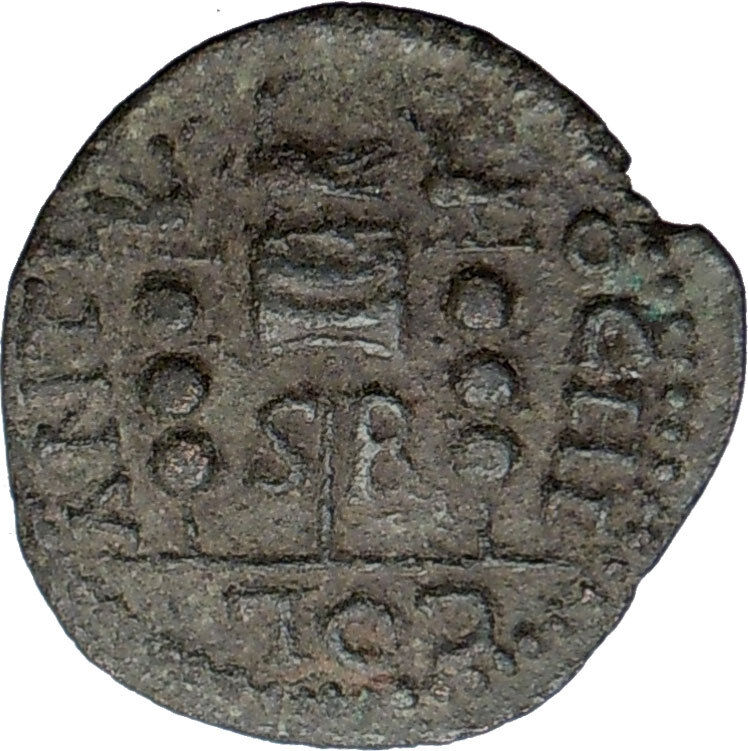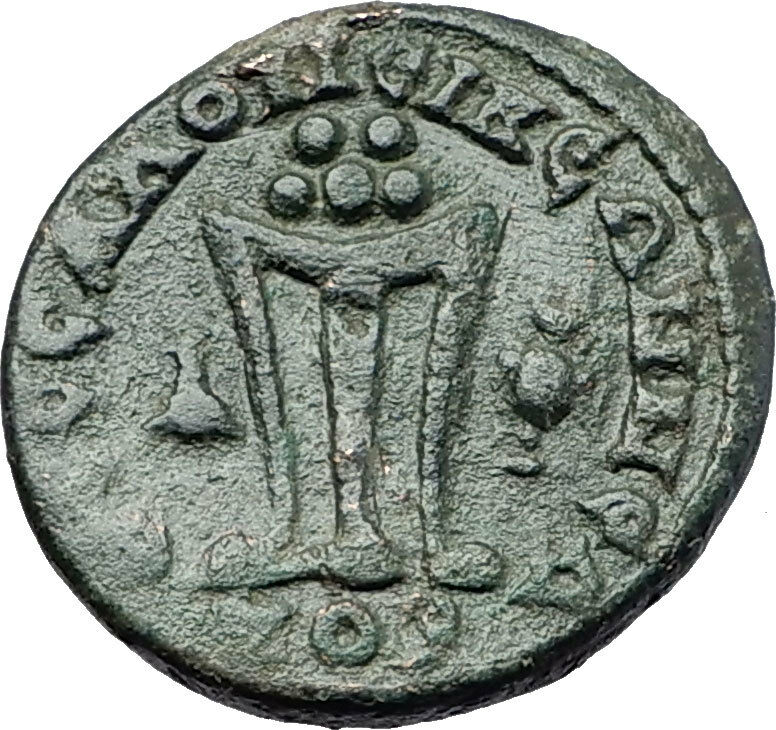|
Geta
– Roman Caesar: 198-209 A.D. –
Roman Emperor
: 209-211 A.D. ––
Bronze 17mm (2.49 grams) of
Marcianopolis
in Moesia Inferior
ΓЄTAC K, Bare head of Geta right.
MAPKIANOΠOΛITΩN,
Serpent
entwined around center leg of
sacrificial tripod.
You are bidding on the exact item pictured,
provided with a Certificate of Authenticity and Lifetime Guarantee of
Authenticity.
A sacrificial tripod is a three-legged piece of religious furniture
used for offerings or other ritual procedures. As a seat or stand, the
tripod
is the most stable furniture
construction for uneven ground, hence its use is universal and ancient. It is
particularly associated with
Apollo
and the
Delphic oracle
in
ancient Greece
, and the word “tripod” comes
from the Greek meaning “three-footed.”

Apollo and
Heracles
struggle for the Delphic
tripod (Attic
black-figure
hydria
, c. 520 BC)
Ancient Greece
The most famous tripod of ancient Greece was the
Delphic
tripod from which the
Pythian priestess
took her seat to deliver the
oracles
of the deity. The seat was formed by a
circular slab on the top of the tripod, on which a branch of
laurel
was deposited when it was unoccupied by
the priestess. In this sense, by Classical times the tripod was sacred to
Apollo
. The
mytheme
of
Heracles
contesting with Apollo for the tripod
appears in vase-paintings older than the oldest written literature. The oracle
originally may have been related to the primal deity, the Earth.
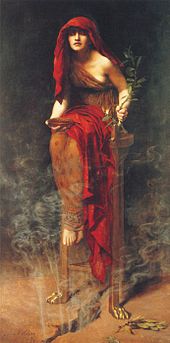
Priestess of Delphi (1891), as imagined by
John Collier
; the Pythia is
inspired by
pneuma
rising from below as she
sits on a tripod
Another well-known tripod in Delphi was the
Plataean Tripod
; it was made from a tenth part
of the spoils taken from the
Persian
army after the
Battle of Plataea
. This consisted of a golden
basin, supported by a
bronze
serpent
with three heads (or three serpents
intertwined), with a list of the states that had taken part in the war inscribed
on the coils of the serpent. The golden bowl was carried off by the
Phocians
during the
Third Sacred War
(356–346 BC); the stand was
removed by the emperor
Constantine
to
Constantinople
in 324, where in modern
Istanbul
it still can be seen in the
hippodrome
, the Atmeydanı, although in
damaged condition: the heads of the serpents have disappeared, however one is
now on display at the nearby Istanbul Archaeology Museums. The inscription,
however, has been restored almost entirely. Such tripods usually had three
ears (rings which served as handles) and frequently had a central upright as
support in addition to the three legs.
Tripods frequently are mentioned by
Homer
as prizes in
athletic games
and as complimentary gifts; in
later times, highly decorated and bearing inscriptions, they served the same
purpose. They also were used as dedicatory
offerings
to the deities, and in the dramatic
contests at the Dionysia
the victorious
choregus
(a wealthy citizen who bore the
expense of equipping and training the chorus) received a crown and a tripod. He
would either dedicate the tripod to some deity or set it upon the top of a
marble structure erected in the form of a small circular temple in a street in
Athens
, called the street of tripods,
from the large number of memorials of this kind. One of these, the
Choragic Monument of Lysicrates
, erected by him
to commemorate his victory in a dramatic contest in 335 BC, still stands. The
form of the victory tripod, now missing from the top of the Lysicrates monument,
has been rendered variously by scholars since the 18th century.
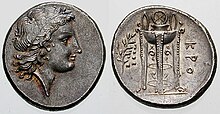
An ancient Greek coin c. 330-300 BC. Laureate head of Apollo (left)
and ornate tripod (right).
Martin L. West
writes that the sibyl at Delphi
shows many traits of
shamanistic
practices, likely inherited or
influenced from Central Asian practices. He cites her sitting in a cauldron on a
tripod, while making her prophecies, her being in an ecstatic trance state,
similar to shamans, and her utterings, unintelligible.
According to Herodotus (The Histories, I.144), the victory tripods were not
to be taken from the temple sanctuary precinct, but left there as dedications.
Sometimes the tripod was used as a support for a
lebes
or cauldron or for supporting other items
such as a vase.
-
Delphic tripod (red-figured
bell-krater
,
Paestum
, c. 330 BC)
Ancient China
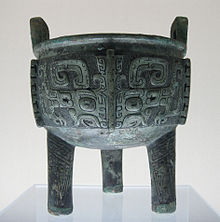
A
ding
from the late
Shang Dynasty
.
Tripod pottery have been part of the archaeological assemblage in China since
the earliest Neolithic cultures of
Cishan
and
Peiligang
in the 7th and 8th millennium BC.
Sacrificial tripods were also found in use in ancient
China
usually cast in bronze but sometimes
appearing in ceramic form. They are often referred to as “dings”
and usually have three legs, but in some usages have four legs.
The Chinese use sacrificial tripods in modern times, such as in 2005, when a
“National Unity Tripod” made of bronze was presented by the central Chinese
government to the government of northwest China’s
Xinjiang Uygur Autonomous Region
to mark its
fiftieth birthday. It was described as a traditional Chinese sacrificial vessel
symbolizing unity.

Serpents
and snakes play a role in many of the world’s myths and legends. Sometimes these
mythic beasts appear as ordinary snakes. At other times, they take on magical or
monstrous forms. Serpents and snakes have long been associated with good as well
as with evil, representing both life and death, creation and destruction.
Serpents and Snakes as Symbols. In religion, mythology, and
literature, serpents and snakes often stand for fertility or a creative life
force—partly because the creatures can be seen as symbols of the male sex organ.
They have also been associated with water and earth because many kinds of snakes
live in the water or in holes in the ground. The ancient Chinese connected
serpents with life-giving rain. Traditional beliefs in Australia, India, North
America, and Africa have linked snakes with rainbows, which in turn are often
related to rain and fertility.
As snakes grow, many of them shed their skin at various times, revealing a
shiny new skin underneath. For this reason snakes have become symbols of
rebirth, transformation, immortality, and healing. The ancient Greeks
considered snakes sacred to Asclepius, the god of medicine. He carried a
caduceus, a staff with one or two serpents wrapped around it, which has become
the symbol of modern physicians.
For both the Greeks and the Egyptians, the snake represented eternity.
Ouroboros, the Greek symbol of eternity, consisted of a snake curled into a
circle or hoop, biting its own tail. The Ouroboros grew out of the belief that
serpents eat themselves and are reborn from themselves in an endless cycle of
destruction and creation.
Serpents figured prominently in archaic Greek myths. According to some
sources,
Ophion (“serpent”, a.k.a. Ophioneus), ruled the world with Eurynome
before the two of them were cast down by Cronus and Rhea. The oracles of the
Ancient Greeks were said to have been the continuation of the tradition begun
with the worship of the Egyptian cobra goddess,
Wadjet.
The
Minoan
Snake
Goddess brandished a serpent in either hand, perhaps evoking her role
as source of wisdom, rather than her role as Mistress of the Animals (Potnia
theron), with a leopard
under each arm. She is a Minoan version
of the Canaanite
fertility goddess
Asherah.
It is not by accident that later the infant
Heracles,
a liminal hero on the threshold between the old ways and the new Olympian world,
also brandished the two serpents that “threatened” him in his cradle. Classical
Greeks did not perceive that the threat was merely the threat of wisdom. But the
gesture is the same as that of the Cretan goddess.
Typhon
the enemy of the Olympian gods is described as a vast grisly monster with a
hundred heads and a hundred serpents issuing from his thighs, who was conquered
and cast into Tartarus
by
Zeus,
or confined beneath volcanic regions, where he is the cause of eruptions. Typhon
is thus the chthonic figuration of volcanic forces. Amongst his children by
Echidna are Cerberus
(a monstrous three-headed dog with a
snake for a tail and a serpentine mane), the serpent tailed
Chimaera
, the serpent-like chthonic water beast
Lernaean Hydra and the hundred-headed serpentine dragon
Ladon.
Both the Lernaean Hydra and Ladon were slain by
Heracles.
Python
was the earth-dragon of
Delphi,
she always was represented in the vase-paintings and by sculptors as a serpent.
Pytho was the chthonic enemy of Apollo
, who slew her and remade her former home
his own oracle, the most famous in Classical Greece.
Amphisbaena a Greek word, from amphis, meaning “both ways”, and
bainein, meaning “to go”, also called the “Mother of Ants”, is a mythological,
ant-eating serpent with a head at each end. According to Greek mythology, the
mythological amphisbaena was spawned from the blood that dripped from
Medusa
the Gorgon‘s
head as
Perseus flew over the Libyan Desert with her head in his hand.
Medusa and the other Gorgons were vicious female monsters with sharp fangs
and hair of living, venomous snakes whose origins predate the written myths of
Greece and who were the protectors of the most ancient ritual secrets. The
Gorgons wore a belt of two intertwined serpents in the same configuration of the
caduceus.
The Gorgon was placed at the highest point and central of the relief on the
Parthenon.
Asclepius, the son of Apollo and Koronis, learned the secrets of
keeping death at bay after observing one serpent bringing another (which
Asclepius himself had fatally wounded) healing herbs. To prevent the entire
human race from becoming immortal under Asclepius’s care, Zeus killed him with a
bolt of lightning. Asclepius’ death at the hands of Zeus illustrates man’s
inability to challenge the natural order that separates mortal men from the
gods. In honor of Asclepius, snakes were often used in healing rituals.
Non-poisonous snakes were left to crawl on the floor in dormitories where the
sick and injured slept. In
The Library
,
Apollodorus claimed that
Athena
gave Asclepius a vial of blood from the Gorgons. Gorgon blood had magical
properties: if taken from the left side of the Gorgon, it was a fatal poison;
from the right side, the blood was capable of bringing the dead back to life.
However
Euripides wrote in his tragedy
Ion
that the Athenian queen Creusa had
inherited this vial from her ancestor Erichthonios, who was a snake himself and
receiving the vial from Athena. In this version the blood of Medusa had the
healing power while the lethal poison originated from Medusa’s serpents.
Laocoön
was allegedly a priest of Poseidon
(or of Apollo, by some accounts) at
Troy;
he was famous for warning the Trojans in vain against accepting the Trojan Horse
from the Greeks, and for his subsequent divine execution. Poseidon (some say
Athena),
who was supporting the Greeks, subsequently sent sea-serpents to strangle
Laocoön and his two sons, Antiphantes and Thymbraeus. Another tradition states
that Apollo sent the serpents for an unrelated offense, and only unlucky timing
caused the Trojans to misinterpret them as punishment for striking the Horse.
Olympias, the mother of
Alexander the Great
and a princess of the
primitive land of
Epirus
, had the reputation of a snake-handler,
and it was in serpent form that Zeus was said to have fathered Alexander upon
her; tame snakes were still to be found at Macedonian
Pella
in the 2nd century AD (Lucian,
Alexander the false prophet
) and at
Ostia
a bas-relief shows paired coiled serpents
flanking a dressed altar, symbols or embodiments of the
Lares
of the household, worthy of veneration (Veyne 1987 illus p 211).
Aeetes
, the king of
Colchis
and father of the sorceress Medea
, possessed the
Golden Fleece. He guarded it with a massive serpent that never slept.
Medea, who had fallen in love with Jason
of the
Argonauts,
enchanted it to sleep so Jason could seize the Fleece.
Publius Septimius Geta (March
7, 189
–December
26, 211
), was a
Roman Emperor
co-ruling with his father
Septimius Severus
and his older brother
Caracalla
from 209 to his death.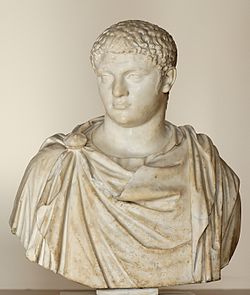
Geta was the younger son of Septimius Severus by his second wife
Julia Domna
. Geta was born in
Rome, at a time when his father was only a provincial governor at the
service of emperor
Commodus
.
Geta was always in a place secondary to his older brother Lucius, the heir
known as Caracalla. Perhaps due to this, the relations between the two were
difficult from their early years. Conflicts were constant and often required the
mediation of their mother. To appease his youngest son, Septimius Severus gave
Geta the title of Augustus in 209. During the campaign against the
Britons of the early 3rd century, the imperial propaganda publicized a happy
family that shared the responsibilities of rule. Caracalla was his father’s
second in command, Julia Domna the trusted counsellor and Geta had
administrative and bureaucratic duties. Truth was that the rivalry and antipathy
between the brothers was far from being improved.
Joint Emperor
When Septimius Severus died in
Eboracum in the beginning of 211, Caracalla and Geta were proclaimed
joint emperors and returned to Rome.

Regardless, the shared throne was not a success: the brothers argued about
every decision, from law to political appointments. Later sources speculate
about the desire of the two of splitting the empire in two halves. By the end of
the year, the situation was unbearable. Caracalla tried to murder Geta during
the festival of
Saturnalia
without success. Later in December
he arranged a meeting with his brother in his mother’s apartments, and had him
murdered in her arms by
centurions
.
Following Geta’s assassination, Caracalla
damned his memoryy
and ordered his name to be
removed from all inscriptions. The now sole emperor also took the opportunity to
get rid of his political enemies, on the grounds of conspiracy with the
deceased. Cassius Dio
stated that around 20,000 persons
of both sexes were killed and/or proscribed during this time.
In
Greek
and
Roman mythology
, a
palladium
or palladion was an
image
of great antiquity on which the safety of
a city was said to depend. “Palladium” especially signified the wooden statue (xoanon)
of Pallas Athena
that
Odysseus
and
Diomedes
stole from the
citadel
of
Troy and which was later taken to the future site of
Rome by Aeneas
. The Roman story is related in
Virgil
‘s
Aeneid
and other works. In
English
, since circa 1600, the word
“palladium” has meant anything believed to provide protection or safety — a
safeguard.

Origins
The Trojan Palladium was said to be a wooden image of
Pallas
(whom the
Greeks
identified with
Athena
and the
Romans
with Minerva) and to have fallen from
heaven in answer to the prayer of
Ilus, the founder of
Troy.
“The most ancient talismanic
effigies
of Athena,”
Ruck
and
Staples
report, “…were magical found objects,
faceless pillars of Earth in the old manner, before the Goddess was
anthropomorphized
and given form through the
intervention of human intellectual meddling.”
Arrival
at Troy
The arrival at Troy of the Palladium, fashioned by Athena in remorse for the
death of Pallas, as part of the city’s
founding myth
, was variously referred to by
Greeks, from the seventh century BC onwards. The Palladium was linked to the
Samothrace mysteries
through the pre-Olympian
figure of an Elektra, mother of Dardanus, progenitor of the Trojan royal line,
and of Iasion
, founder of the Samothrace mysteries.
Whether Electra had come to Athena’s shrine of the Palladium as a pregnant
suppliant and a god cast it into the territory of Ilium, because it had been
profaned by the hands of a woman who was not a virgin, or whether Elektra
carried it herself or whether it was given directly to Dardanus vary in sources
and
scholia
. In Ilion, King
Ilus was blinded for touching the image to preserve it from a burning
temple.
Theft
During the
Trojan War
, the importance of the Palladium to
Troy was said to have been revealed to the Greeks by
Helenus
, the prophetic son of
Priam
. After Paris’ death, Helenus left the
city but was captured by Odysseus. The Greeks somehow managed to persuade the
warrior seer to reveal the weakness of Troy. The Greeks learned from Helenus,
that Troy would not fall while the Palladium, image or statue of Athena,
remained within Troy’s walls. The difficult task of stealing this sacred statue
again fell upon the shoulders of Odysseus and Diomedes. Since Troy could not be
captured while it safeguarded this image, the Greeks
Diomedes
and
Odysseus
made their way to the
citadel
in Troy by a
secret passage
and carried it off. In this way
the Greeks were then able to enter Troy and lay it waste using the deceit of the
Trojan Horse
.
Odysseus, some say, went by night to Troy, and leaving Diomedes waiting,
disguised himself and entered the city as a beggar. There he was recognized by
Helen
, who told him where the Palladium was.
Diomedes then climbed the wall of Troy and entered the city. Together, the two
friends killed several guards and one or more priests of Athena’s temple and
stole the Palladium “with their bloodstained hands”. Diomedes is generally
regarded as the person who physically removed the Palladium and carried it away
to the ships. There are several statues and many ancient drawings of him with
the Palladium.
According to the
Epic Cycle
narrative of the
Little Iliad
, on the way to the ships,
Odysseus plotted to kill Diomedes and claim the Palladium (or perhaps the credit
for gaining it) for himself. He raised his sword to stab Diomedes in the back.
Diomedes was alerted to the danger by glimpsing the gleam of the sword in the
moonlight. He disarmed Odysseus, tied his hands, and drove him along in front,
beating his back with the flat of his sword. From this action was said to have
arisen the Greek proverbial expression “Diomedes’ necessity”, applied to those
who act under compulsion. Because Odysseus was essential for the destruction of
Troy, Diomedes refrained from punishing him.
Diomedes took the Palladium with him when he left Troy. According to some
stories, he brought it to Italy. Some say that it was stolen from him on the
way.
Arrival
at Rome
According to various versions of this legend the Trojan Palladium found its
way to Athens
, or
Argos
, or
Sparta
(all in
Greece
), or
Rome in Italy
. To this last city it was either brought
by Aeneas the exiled Trojan (Diomedes, in this version, having only succeeded in
stealing an imitation of the statue) or surrendered by Diomedes himself. It was
kept there in the
Temple of Vesta
in the
Roman Forum
.
Pliny the Elder
said that
Lucius Caecilius Metellus
had been blinded by
fire when he rescued the Palladium from the
Temple of Vesta
in 241 BC, an episode alluded
to in Ovid
and
Valerius Maximus
When the controversial emperor
Elagabalus
(reigned 218-222) transferred the
most sacred relics of Roman religion from their respective shrines to the
Elagabalium
, the Palladium was among them.
In
Late Antiquity
, it was rumored that the
Palladium was transferred from Rome to
Constantinople
by
Constantine the Great
and buried under the
Column of Constantine
in his forum. Such a move
would have undermined the primacy of Rome, and was naturally seen as a move by
Constantine to legitimize his reign.
|













